Loudness Penalty
Quick Answer
A “Loudness Penalty” is the amount in dB your mix or master will be turned down by loudness normalization. Loudness normalization occurs right before streaming and is something any engineer or artist needs to keep in mind before distributing their mix or master for distribution.
The Loudness Penalty in Detail
The notion of a penalty for mastering too loud is relatively new. Only a decade ago, engineers could master music as loud as the CD format or digital file could withstand before distortion.

The loudness of masters changes with the medium onto which they're distributed.
Although this didn’t lead to the best sounding music, it was a possibility for those who wanted their music loud. This possibility is nearly gone today, as the primary medium has been switched from CD and digital download to streaming services.
At first, the majority of streaming services didn’t alter uploaded and streamed music in a noticeable way. The quality of the MP3 used may have been lower due to storage and streaming limitations, but for the most part, the sonic characteristics of a master were left intact.

Streaming services didn't change the loudness of songs at first, but now loudness normalization is common.
This has since changed with the popularization of a software known as ReplayGain, the process of loudness normalization, and the ability of listeners to control the normalization settings of the music they listen to.

ReplayGain measures the loudness of a track and is an important part of understanding the Loudness Penalty.
Each of these things has either led to a loudness penalty or affects it in one way or another. With that said, let’s look into how the loudness penalty came to be, the software that caused it to become a key player in mastering music, what it is exactly as well as the plugin that goes by the same name, and some of the factors that can make it more complex than it is currently being portrayed.
Lastly, we’ll discuss whether or not a loudness “penalty” is truly a bad thing for the quality of your master.
If you’re interested in getting a free mastered sample of your mix, send it to us here: https://www.sageaudio.com/register.php
We’ll master it for you using solely analog equipment.
What is ReplayGain?
ReplayGain is a software released in 2001, which analyzes a signal’s integrated LUFS, as well as the signal’s peak, and either amplifies or attenuates a signal according to a set ‘Target Loudness.’ This software is used for popular streaming services such as Spotify and affects music on that streaming service.
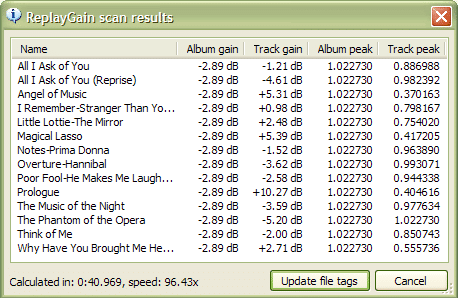
ReplayGain has been around since the early 2000s.
ReplayGain works right before music is streamed. It encodes pertinent information onto the file, that can be read before each playback - this information dictates the extent to which a signal is turned up or down.
Again, ReplayGain works by first analyzing the integrated LUFS* of a file. An integrated LUFS is the measurement of the track’s loudness over time. By measuring a track over time, ReplayGain can more accurately determine the volume of a track, and in turn, encode it with the correct information for normalized playback.

Although ReplayGain uses an undisclosed method of measuring volume over time, it is very similar to an integrated LUFS meter.
In addition to integrated LUFS, ReplayGain measures the peak of the signal. With these two metrics, it can adjust the gain of a signal.
*Although ReplayGain does not use the ITU 1770 integrated LUFS standard, it does use an undisclosed integrated loudness measurement that behaves similarly.
What is Target Loudness?

ReplayGain will Normalize your audio to a set target loudness.
Target Loudness is the setting with which software such as ReplayGain determines if a track should be turned up, or turned down. If a signal exceeds the target loudness setting, ReplayGain will turn it down - if a signal falls below the target loudness setting, it will be turned up.
This loudness can be set by any individual or company using the software, and can vary from streaming service to streaming service. Target loudness can get more complex when streaming services provide their listeners with loudness normalization options.

Spotify allows listeners to change their loudness normalization settings.
For example, Spotify offers a quiet, normal, and loud normalization setting. When a new setting is selected, the target loudness is adjusted for that user’s Spotify account, which causes ReplayGain to adjust the music or signal differently.
What is Loudness Normalization?
Loudness normalization is the process of using the software ReplayGain or similar software to adjust a signal’s loudness to a target loudness during playback. Unlike ReplayGain or Target Loudness, Loudness Normalization is the actual process of changing a signal, not the software nor a software parameter.
Although this may seem like we’re indulging in semantics, it’s important to distinguish what software and functions are used during loudness normalization, from what loudness normalization is in and of itself.
It’s also important to note that loudness normalization can occur outside of a streaming service, and with software other than ReplayGain.
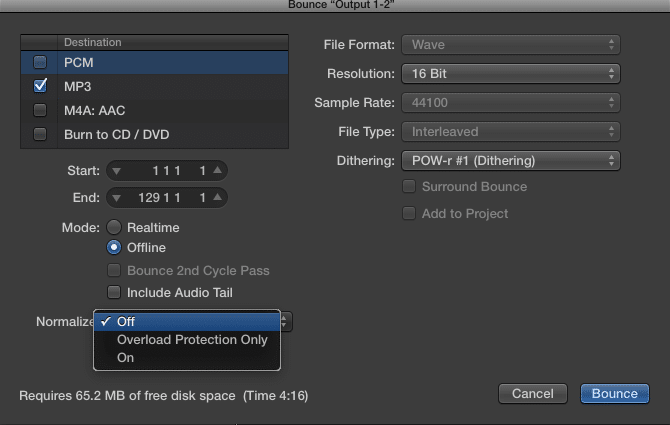
Normalization types vary from peak to loudness normalization.
With that said, the most common forms of normalization that occur outside of streaming typically are not loudness normalization, but peak loudness normalization.
In your DAW, you may see an option for normalization and think that you are encountering the same software and process we just discussed; however, this is most likely peak normalization which affects the signal in a very different manner.
Whereas loudness normalization affects the signal based on its integrated LUFS, peak loudness normalization measures the loudest peak in a selected signal and adjusts the entirety of a signal according to that peak.

Peak normalization bases normalization not on the loudness but on the peak value.
Loudness normalization is used during streaming, whereas peak normalization is not. Keep this in mind whenever you encounter the term “Normalization” and do some research to determine which form you’re dealing with.
Here are some quick definitions to reiterate the distinctions between all of the aforementioned terms:
ReplayGain: The software used to normalize audio.
Integrated LUFS: The loudness of a signal over time.
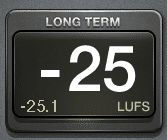
Long term or integrated LUFS is measured over time.
Signal Peak: The loudest peak of a signal.

A true peak meter can help you measure your signal's peak.
Target Loudness: The desired integrated LUFS set within ReplayGain.
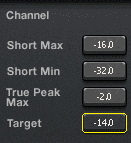
You can set your target loudness to match that of Spotify's.
Loudness Normalization: The process of using ReplayGain to turn up or down a signal, based on the target loudness.
Why do Streaming Services Use Loudness Normalization?
It may seem strange that a streaming service would take it upon themselves to alter the loudness of a track. After all, it should be the decision of the mastering engineer and the artist how loud they want their music to be.

It seems strange that streaming services are enforcing normalization, but it does make sense why they do so.
But when you start to think about it, the need for streaming services to control loudness makes perfect sense.
If you were to run a large streaming service, one that maintains its popularity by the quality of its listeners' experience, it would be crucial for you to maintain that quality.
That’s why when services like Spotify began receiving complaints about huge differences in loudness from one song to another, they took notice.

Consumers were complaining about the difference in volume amongst tracks.
Multiple listeners wrote in to customer support telling stories regarding hearing damage and blown speakers, all due to quiet tracks being followed by incredibly loud ones when shuffling through music.
Naturally, this was cause for alarm, and streaming services sought to control the loudness of tracks during playback to avoid further complaints, or worse, possible lawsuits.
With that said, ReplayGain and other software were adopted and loudness normalization became the default option for playback amongst most streaming services.
What is Loudness Penalty?
Now that we have covered all the parts that make a loudness penalty possible, let’s delve into the details of the loudness penalty.
As stated previously, the loudness penalty is the amount that your song or track will be turned down during loudness normalization. This “Penalty” occurs in decibels and corresponds to the “Target Loudness” set for that streaming service.
It should be noted that the amount your music gets turned down, or “penalized” can change whenever the target loudness is changed. This means that a streaming service can alter a target loudness whenever the company behind it decides to do so. All this to say that the “Loudness Penalty” has the potential to be a moving target, and should be treated as such.

Streaming services can alter their target loudness settings, in turn changing how audio is normalized.
Let’s look at some examples.
Let’s say that Spotify sets it’s “Target Loudness” to -14 LUFS. Your track has an integrated LUFS of -12. This means that ReplayGain will turn down your track by 2dB. In this example, the -2dB change is your “penalty” for mastering too loud.
Next, let’s look at Apple Music. Say you upload this same song to Apple Music, which employs a “Target Loudness” of -16 LUFS. Again, your track has an integrated LUFS of -12. This time, your track will be turned down 4dB to correspond with Apple Music’s target loudness. In this example, your “penalty” is a -4dB change.
(Granted, these examples are not exact, considering ReplayGain uses peaks when determining loudness, and Apple Music uses an entirely different algorithm to determine loudness - which it has yet to disclose. With that said, mastering with these metrics in mind will get you close to how your music will be affected.)
This may seem simple at first, but with the introduction of multiple user settings, and varying target loudness settings amongst various streaming services, it can get more complex.
If you’d like to learn more about how different streaming services set their loudness normalization, check out our blog titled “Master Music for Streaming.” In it, you’ll find a list of various streaming services, their set “Target Loudnesses” and the amount your track will be turned up or down by Loudness Normalization.
If you’re curious about loudness, take a look at another blog of ours titled “How Loud Should My Mix Be?”****It goes into detail about this very topic.
What is the Loudness Penalty Plugin?
Recently, the audio company MeterPlugs released a plugin that can determine how your master will be affected by loudness normalization on various streaming services.
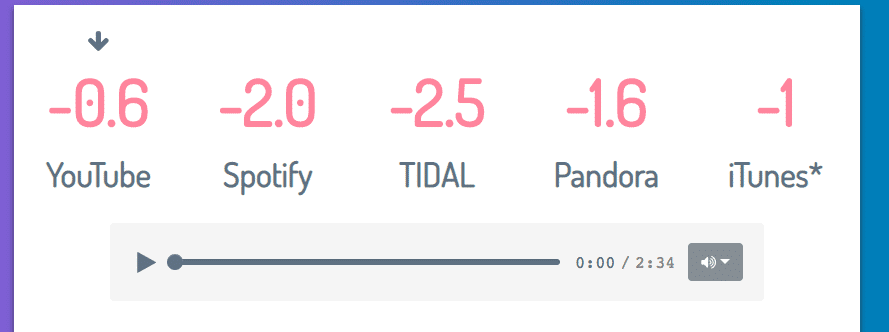
The loudness penalty plugin and show you how much your master will be turned up or down.
These streaming services include Spotify, Apple Music, Pandora, Tidal, and YouTube. According to the company, their method for measuring your music will result in a reading that’s within .5dB of how your music will be normalized.
This can certainly be a useful plugin and does offer a quick and easy way to see how your music or signal will be affected by various streaming services.
With that said, the method with which they determine these changes is to a certain extent inaccurate and can be accomplished almost as well by using an LUFS meter.
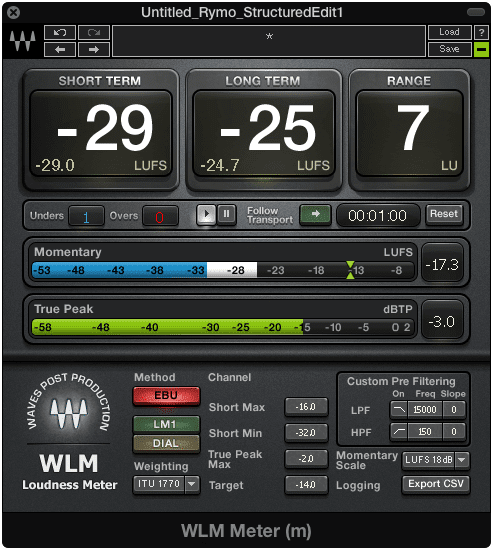
A loudness meter can give you reliable results for setting loudness levels when mastering.
For example, the means by which the plugin determines the loudness normalization settings of Spotify is by measuring a track with ReplayGain, and then adding 3dB to ReplayGain’s value. Based on their experiments, this method results in a range between the estimated normalization changes and actual normalization changes of 0.1dB to 0.5dB. In other words, they are typically inaccurate by 0.1 to 0.5dB
Based on the levels provided by these same experiments, if you mastered your music assuming that Spotify would normalize the audio to an integrated LUFS of -14, and in turn used -14 LUFS as your target, then this method would result in a range between the estimated normalization changes and actual normalization changes of 0.0 dB to 0.8dB. In other words, this method is typically inaccurate by 0.0dB to 0.8dB
In short, using an integrated LUFS of -14 for your target loudness can get you relatively accurate results when mastering for Spotify.
Furthermore, the measurements provided by the plugin don’t seem to account for the various normalization loudness settings Spotify provides its listeners.
According to Spotify, they offer a Loud (-11 LUFS) a Normal (-14 LUFS) and a Quiet (-23 LUFS) normalization setting for their premium listeners. If you wanted to use MeterPlugs’ method for calculating the ‘Loud’ and ‘Quiet’ settings for Spotify’s normalization you would need to measure your track’s ReplayGain value, and then add +6dB, or subtract -5dB respectively. As of now, these additional settings are not included in the plugin.

Spotify's normalization can be controlled by its users.
Lastly, Spotify states that it will soon be converting its loudness normalization settings from ReplayGain’s to the ITU 1770 loudness standard - the same standard used to determine integrated LUFS. This means that your integrated LUFS meters will soon be the most accurate way to combat the loudness “penalty.”

Spotify plans to use different software for normalization in the future.
This is of course not to say whether or not to purchase the plugin, but simply for the sake of having a transparent explanation of the processing and measuring that is occurring behind the plugin, and to offer an accurate representation of using an integrated LUFS plugin to master for streaming services.
Is a Loudness “Penalty” a Negative Thing?
Typically the word penalty indicates that something negative has occurred. The term loudness penalty makes it seem that having your music normalized is a bad thing. This can be the case in certain situations, but not in all situations.
For example, if your loudness penalty was 1dB, that really isn’t an issue. In that regard, it’s not a penalty, but simply an amount your master has been turned down. It’s important to note that loudness normalization is non-destructive, nor does it affect the dynamic range of your track.
That being said, if you were to master your music to be -8 LUFS, and you sacrificed your dynamics to accomplish this only to have that track turned down to -14 LUFS, you’re not doing yourself any favors.

It doesn't make sense to master something loudly, for it to be turned down.
When played back-to-back amongst other, more dynamic masters, your master will sound worse in comparison. So, only when your track is being turned down a fair amount does the term penalty accurately describe what’s happening to your master.

When played against other masters at the same volume, more dynamic masters will sound better.
If you’d like to learn more about dynamics and how it relates to mastering, here is a blog with some additional information on that topic: https://www.sageaudio.com/blog/mastering/10-things-you-should-know-about-music-mastering.php
Is There a “Penalty” for Mastering Too Quietly?
There can be negative consequences for mastering your music too quietly. In an analog mastering setup you can offset your signal-to-noise ratio, but when it comes to normalization, a very dynamic and relatively quiet master can present a problem.

Mastering something too quietly can have negative implications when normalized.
Say the average volume of a track is -25 LUFS, but there are peaks at -10 LUFS. If the target loudness is -14 LUFS, then the overall volume will need to be increased, while the peaks will need to be truncated. Due to the large distance between the peaks and the average volume, these peaks will need to be truncated a fair amount, which will cause distortion.
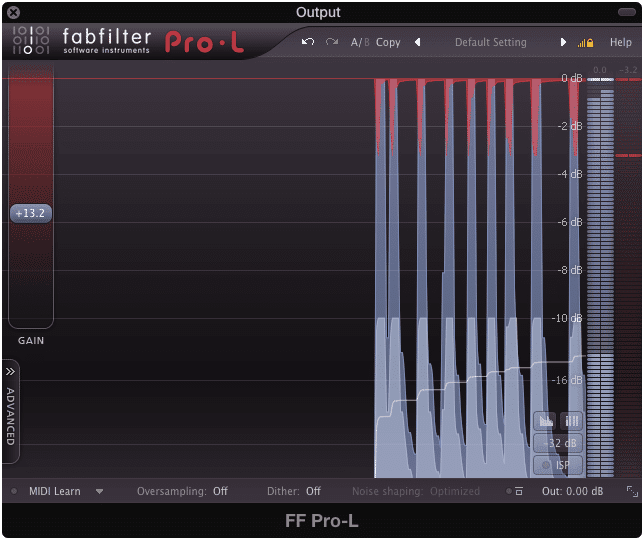
Huge differences between the average volume and the peak volume can result in limiting.
Although this is an extreme example, it does illustrate that when it comes to loudness normalization, mastering loudly isn’t the only consideration an engineer needs to keep in mind while mastering.
Although all cases are slightly different, mastering with an integrated LUFS of -15, and keeping peaks lower than -2dB on a True Peak meter, will be a great target for Spotify.
Conclusion
This may have been a lot of information at once, but hopefully, it has been helpful nonetheless. Keep in mind that as loudness targets change, loudness normalization will change as well.
With that said, it’s necessary to stay informed regarding any changes made to these settings.

Tidal is currently the only streaming service normalizing using the ITU 1770 standard.
For example, keep in mind when Spotify changes its loudness normalization software from ReplayGain to another software with ITU 1770 measurements. It’s possible they may change their loudness targets as well.
Let’s recap the information presented, just to understand it as simply as possible.
A “loudness penalty” occurs when your master is turned down by loudness normalization.
Your master will be turned down if it goes over the “Target loudness” of the normalization software.
Despite the title “loudness penalty,” there truly isn’t a negative effect when your music is turned down, as the software used to do so is non-destructive, nor does it affect the dynamic range.
The only time loudness normalization can alter a signal in a negative manner, is when it amplifies a quiet, highly dynamic master.
If you’d like to have your music mastered, and hear a free mastered sample, send it to us here: https://www.sageaudio.com/register.php
Do you have a grasp on how normalization affects your master?




